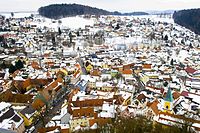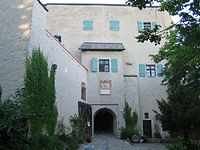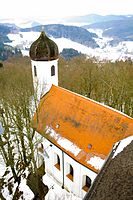Falkenstein Castle (Upper Palatinate)
| Falkenstein Castle | ||
|---|---|---|
|
Falkenstein Castle - view from the south |
||
| Creation time : | before 1074 | |
| Castle type : | Höhenburg, summit location | |
| Conservation status: | Get or get essential dividers | |
| Standing position : | Regensburg Monastery | |
| Place: | Falkenstein | |
| Geographical location | 49 ° 5 '57.1 " N , 12 ° 29' 3.5" E | |
| Height: | 626 m above sea level NHN | |
|
|
||
The Falkenstein Castle is a hilltop castle above the health resort of Falkenstein in Upper Palatinate district of Cham in Bavaria .
Geographical location
The castle is located on a granite rock at 626 m above sea level. NHN and around 60 meters above the valley floor of the Perlbach . When visibility is good, the view extends from the tower to the Großer Arber in the east.
history
The settlement of the rural region and the emergence of Falkenstein Castle can be traced back to the Regensburg bishops , including Bishop Wolfgang and Bishop Tuto , towards the middle of the 10th century. The bishops wanted to secure their property in the area and commissioned canons to better protect the areas, as they were better able to do this with their personal power than the bishops. The castle was built at the time when the mighty Counts von Bogen held the Domvogtei in Regensburg. The construction of the castle was not directed by the Counts of Bogen, but by a faithful named Falko, who thus became the founder of the Falkenstein family. The ownership of the castle and the place have changed very often, which was also due to the fact that the duchies and national borders often changed in the Middle Ages. After the owners of Falkenstein Castle were rarely present, they entrusted so-called keepers , who were their deputies. Falkenstein Castle was owned by Count Friedrich I. von Bogen from 1075 to 1101. From 1101 to 1136 Count Friedrich II followed. The ruling Duke Heinrich the Proud quarreled with Count Friedrich II over the cathedral bailiwick, and Friedrich II lost Falkenstein Castle to Duke Heinrich. Two years later, the Regensburg bishop Konrad died and the friends of Count Friedrich II. Elected Count Heinrich von Wolfratshausen as their new bishop . Angry, Duke Heinrich the Proud moved to Regensburg, devastated a part of Regensburg and took Falkenstein Castle. In 1133, Count Palatine Otto von Wittelsbach established peace, and Count Friedrich II received the Falkenstein Bailiwick back. When Friedrich II died, his son Friedrich III inherited. (1136–1149) the bailiwick. Friedrich III. followed King Conrad III. in the crusade against the French and was killed in the process. Count Berthold von Bogen took over the inheritance until 1168, after which Count Albert III. from Bogen to his death in 1196. Then his son, Count Albert IV. Von Bogen, inherited the Domvogt until his death in 1242. Albert III's widow, Ludmilla Duchess of Bohemia, married Duke Ludwig I of Bavaria .
After their son Albert IV von Bogen died in 1242 without an heir, the county of Bogen (with its white and blue diamond coat of arms) passed to his half-brother, Duke Otto II of Bavaria , and from then on remained in the hands of the Wittelsbach family.
From now on, Duke Otto II of Bavaria ruled Falkenstein, with the bishops still being the owners and the canons their representatives. When the property passed to the Hohenfels is not known, but the incumbent bailiff Konrad II von Hohenfels got into a dispute with the neighbors to Brennberg in 1232 in order to reach an agreement, he returned the Falkenstein castle to the Regensburg bishop Siegfried . A few years later, however, the Hohenfels residents got the Falkenstein rule back from Bishop Siegfried . On December 28, 1250, Konrad II von Hohenfels tried to murder King Konrad IV on behalf of the Bishop of Regensburg, the assassination attempt failed and Konrad II had to flee. When King Konrad IV died, he reappeared, but not with the name Hohenfels, but Ehrenfels , Konrad II von Ehrenfels (1256). After his death, his son Konrad III. Successor (1267-1290). However, his two sons Konrad and Heinrich got involved in more and more disputes with their neighbors. After the imperial ban was imposed, Heinrich von Hohenfels-Falkenstein was forced to sell the castle to King Ludwig IV in 1323 . King Ludwig IV did not have the money and borrowed it from Landgrave Ulrich I von Leuchtenberg . However, since he was unable to repay the amount, King Ludwig IV left the castle and rule to Landgrave Ulrich I von Leuchtenberg in 1327. In 1332, Landgrave Ulrich I von Leuchtenberg sold the Falkenstein house with all rulership to Duke Heinrich XV. of Bavaria . This is how Falkenstein came to Lower Bavaria. After the Lower Bavarian line of the Wittelsbach family died out in 1340, the market fell back to King Ludwig IV .
Due to persistent financial difficulties, King Ludwig IV seized Falkenstein Castle in 1347 to Count Wolfahrt den Satzenhofer , court master of the margrave. Falkenstein Castle was thoroughly renovated under his ownership in 1347. Wolfahrt den Satzenhofer died childless in 1360 and inherited his brother Dietrich Satzenhofer, mayor of Regensburg, who was followed in 1374 by his sons Dietrich and Hans. In 1379, Duke Albrecht I of Lower Bavaria-Straubing redeemed Falkenstein. Until the line Niederbayern-Straubing died out in 1425, the noble families Wilhelm II followed and then his brother Johann III.
In 1429 Falkenstein came to Bavaria-Munich under the rule of Duke Ernst after a regional reform . 1467 was his son Albrecht III. Sole ruler until his death in 1508. From 1514, his son Wilhelm IV left the castle and rule of Falkenstein to his court master to the knight Hieronymus von Stauff until his execution for high treason in 1516. However, the castle and rule of Falkenstein remained in the possession of his son Hans Ruprecht from Stauf. Due to his lavish life, he sold one castle after another, so Falkenstein came to Duke Ludwig X of Bavaria in 1526 . Duke Ludwig X. left Falkenstein to his court marshal Ludwig von Pienzenau . Count Michael von Preysing married the daughter of court marshal Ludwig von Pienzenau and was the owner of Falkenstein until his death in 1544. His older daughter Melusina Preysing married Hieronymus von Seiboldsdorf in 1565 and he became Lord of Falkenstein. The young castle owner died in 1574 and when the estate was divided in 1590, Falkenstein Castle fell to the youngest daughter Anna, so that Bernhard Nothaft von Wernberg became the lord of Falkenstein.
Bernhard Nothaft's daughter married Freiherr Ferdinand Khuen von Belasy, after his early death in 1620, the widow married Freiherr Wolf Dietrich von Maxlrain and, after his death, Freiherr Johann Heinrich von Haslang zu Haslangskreuth (1629). During the Swedish War, Haslang, he was court war councilor and field colonel, was taken prisoner. In 1634, when Haslang was in captivity, Falkenstein Castle was conquered by the Swedes and burned down. During the second invasion of Sweden in 1641, the castle could not be conquered by the Swedes and the third time the enemy did not dare to get any closer to Falkenstein Castle. Maria Euphemia Haslang died in 1662, her two daughters from her marriage to Wolf Dietrich von Maxlrain inherited it in equal parts. After an inheritance dispute between Haslang and Törring, Falkenstein went to Count Maximilian von Törring zu Jettenbach in 1664. Count Maximilian von Törring zu Jettenbach died around 1666 and left behind two underage sons, Fanz Josef and Leonhard Simpert von Törring-Jettenbach , who ruled together in 1678 after they came of age.
In the 17th century, the castle was remodeled with late Renaissance elements, such as the arcades on the ground floor and the upper floor. The castle chapel attached to the castle goes back to Count Törring (from 1664). From 1715 Leonhard Simpert von Törring-Jettenbach ruled together with Field Marshal Count Josef Ignaz Felix von Törring and from 1734 Count Josef Ignaz Felix von Törring with Count Maximilian Joseph I. von Törring. The inheritance in 1763 was shared by Max Emanuel von Toerring-Jettenbach and Count Norbert Johann, until in 1769 Count Norbert Johann handed over his share of the inheritance to his cousin Max Emanuel von Toerring-Jettenbach. After his death in 1773, his brother August von Toerring-Seefeld followed him as Lord von Falkenstein. Count Joseph August von Toerring took over the inheritance until 1826.
His successor Maximilian Josef sold the entire Falkenstein estate to the princely Thurn und Taxis in Regensburg on October 22, 1829. The owner was Maximilian Joseph von Thurn und Taxis until 1872 , then Maximilian Maria von Thurn und Taxis followed until 1888, which was followed by Albert von Thurn und Taxis . Then came Johannes von Thurn und Taxis . Due to the lack of use, the complex fell into such disrepair in the 19th and 20th centuries that in 1967 the Falkenstein market had to purchase the castle in need of renovation for a symbolic price of one mark in order to save it from final ruin. In 1978 the renovation work was completed. Since then, the restored castle has served as the "Haus des Gastes" with a restaurant and a museum for hunting and game, which is based on the collection of hunting trophies of the Hamburg notary Hans-Werner Schacht (1907–1981). Burghofspiele take place annually in the inner courtyard.
Building description
The complex consists of a 40 × 40 meter fore and main castle , the latter being divided into upper and lower castle. The quarry-stone-walled ring wall of the outer bailey is mostly only preserved as a lining wall and connects to the so-called "Weiberwehr" in the northwest. The narrow courtyard is an elongated pentagon of approx. 45 × 29 meters, which you enter from the strategically bent and arched doorway. Above the gate is the alliance coat of arms of Belasy / Nothracht. The outer walls of the lower castle, which are up to 1.50 meters wide, belong to the oldest building stock of the castle complex, which is more likely to date to the 13th century. The square, five-storey keep with the dimensions of 8.5 × 8.5 meters, which is now used as a lookout tower , stands on the steep rock in the west . The castle chapel is a hall building with a needle cap barrel on consoles with post-Gothic ornamental ribs, a small square west tower with an octagon top and onion dome and a choir rounded at the bottom and closed on three sides at the top .
Surroundings
The surrounding 13.748 hectare park is the second largest nature and rock park in Bavaria and is designated as a nature reserve Schlosspark Falkenstein . There you can also find the very rare, light-reflecting light moss . Individual rocks are also designated as geotopes . The Klause, the Froschmaul, Steinernes Gässchen, Hohler Stein and Himmelsleiter are highlights of a hike through the castle park.
Trivia
When the Hussites threatened the Falkenstein around 1430 , the kennel was defended by courageous women, and the parapet walk around the wall was then called the “women's guard”.
- Falkenstein Castle / Upper Palatinate on February 24, 2010
literature
- Bernhard Ernst: Castle building in the south-eastern Upper Palatinate from the early Middle Ages to the early modern period. Volume 2: Catalog . Publishing house Dr. Faustus, Büchenbach 2003, ISBN 3-933474-20-5 , pp. 74-81.
- Andrea Krottenthaler: The Lords of Falkenstein (Opf.) In the 12th century . Approval thesis, University of Regensburg 1999, BVB number: BV017558224, University Library of Regensburg.
- Josef Heigl: Falkenstein Upper Palatinate . Falkenstein Market 1997.
- Karl Bosl (Hrsg.): Bavaria (= manual of the historical sites of Germany . Volume 7 ). 3. Edition. Kröner, Stuttgart 1981, ISBN 3-520-27703-4 , pp. 295 ff . ( Kröner's pocket edition. Volume 277.).
- Josef Beer: 900 year old Falkenstein. Climatic health resort in the Bavarian Forest . Cham 1988.
- Curt Tillmann: Lexicon of German castles and palaces: Aach to Marzoil . Volume 1, Hiersemann Verlag, Stuttgart 1958, ISBN 978-3-7772-5810-2 .
- August Sieghardt: Upper Palatinate: Landscape, History, Culture, Art. Volume 3 of the North Bavarian Regional Studies Library, Glock and Lutz, Nuremberg 1965, p. 402.
- Hermann Reidel: From profanation to cult building. Examples from Regensburg and the Upper Palatinate . In: Against transience . Universitätsverlag Regensburg 2005, ISBN 3-930480-69-7 , pp. 28–33.
Web links
- Entry on Falkenstein in the private database "Alle Burgen".
- Homepage of the castle
- Falkenstein Castle on the side of the House of Bavarian History
- Aerial photos of the castle and the place
- Entry by Bernhard Ernst on Falkenstein Castle in the scientific database " EBIDAT " of the European Castle Institute
- Falkenstein Castle at burgseite.de
Individual evidence
- ↑ a b Bernhard Ernst: Castle building in the southeastern Upper Palatinate. From the early Middle Ages to the early modern period . P. 74 ff.
- ↑ a b Michael Weithmann: Castles and palaces in Bavaria. Niederösterreichisches Pressehaus, Druck und Verlagsgesellschaft mbH, St. Pölten 2003, ISBN 3-85326-175-2 , p. 147.
- ↑ Markt Falkenstein Information on Falkenstein Castle. Markt Falkenstein, 2008, accessed February 24, 2010.












